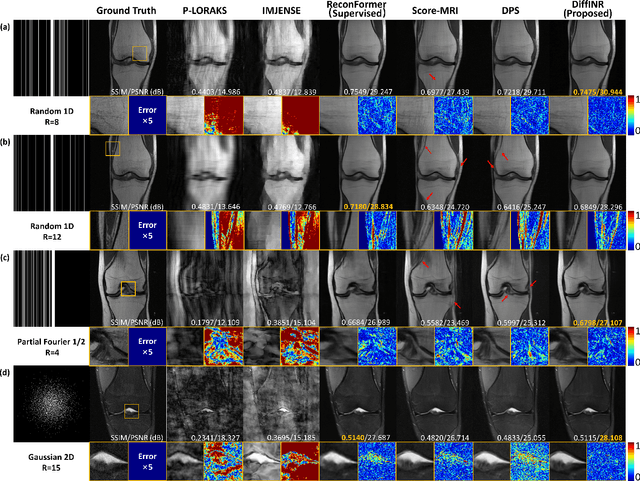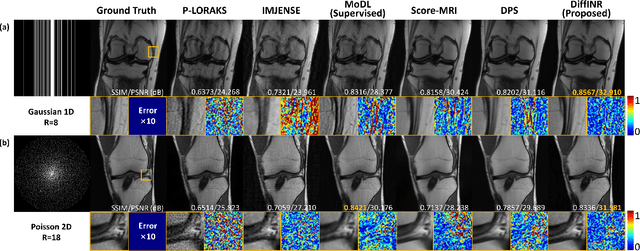Yuyao Zhang
Unsupervised Self-Prior Embedding Neural Representation for Iterative Sparse-View CT Reconstruction
Feb 08, 2025Abstract:Emerging unsupervised implicit neural representation (INR) methods, such as NeRP, NeAT, and SCOPE, have shown great potential to address sparse-view computed tomography (SVCT) inverse problems. Although these INR-based methods perform well in relatively dense SVCT reconstructions, they struggle to achieve comparable performance to supervised methods in sparser SVCT scenarios. They are prone to being affected by noise, limiting their applicability in real clinical settings. Additionally, current methods have not fully explored the use of image domain priors for solving SVCsT inverse problems. In this work, we demonstrate that imperfect reconstruction results can provide effective image domain priors for INRs to enhance performance. To leverage this, we introduce Self-prior embedding neural representation (Spener), a novel unsupervised method for SVCT reconstruction that integrates iterative reconstruction algorithms. During each iteration, Spener extracts local image prior features from the previous iteration and embeds them to constrain the solution space. Experimental results on multiple CT datasets show that our unsupervised Spener method achieves performance comparable to supervised state-of-the-art (SOTA) methods on in-domain data while outperforming them on out-of-domain datasets. Moreover, Spener significantly improves the performance of INR-based methods in handling SVCT with noisy sinograms. Our code is available at https://github.com/MeijiTian/Spener.
Search-o1: Agentic Search-Enhanced Large Reasoning Models
Jan 09, 2025



Abstract:Large reasoning models (LRMs) like OpenAI-o1 have demonstrated impressive long stepwise reasoning capabilities through large-scale reinforcement learning. However, their extended reasoning processes often suffer from knowledge insufficiency, leading to frequent uncertainties and potential errors. To address this limitation, we introduce \textbf{Search-o1}, a framework that enhances LRMs with an agentic retrieval-augmented generation (RAG) mechanism and a Reason-in-Documents module for refining retrieved documents. Search-o1 integrates an agentic search workflow into the reasoning process, enabling dynamic retrieval of external knowledge when LRMs encounter uncertain knowledge points. Additionally, due to the verbose nature of retrieved documents, we design a separate Reason-in-Documents module to deeply analyze the retrieved information before injecting it into the reasoning chain, minimizing noise and preserving coherent reasoning flow. Extensive experiments on complex reasoning tasks in science, mathematics, and coding, as well as six open-domain QA benchmarks, demonstrate the strong performance of Search-o1. This approach enhances the trustworthiness and applicability of LRMs in complex reasoning tasks, paving the way for more reliable and versatile intelligent systems. The code is available at \url{https://github.com/sunnynexus/Search-o1}.
Unsupervised Multi-Parameter Inverse Solving for Reducing Ring Artifacts in 3D X-Ray CBCT
Dec 08, 2024
Abstract:Ring artifacts are prevalent in 3D cone-beam computed tomography (CBCT) due to non-ideal responses of X-ray detectors, severely degrading imaging quality and reliability. Current state-of-the-art (SOTA) ring artifact reduction (RAR) algorithms rely on extensive paired CT samples for supervised learning. While effective, these methods do not fully capture the physical characteristics of ring artifacts, leading to pronounced performance drops when applied to out-of-domain data. Moreover, their applications to 3D CBCT are limited by high memory demands. In this work, we introduce \textbf{Riner}, an unsupervised method formulating 3D CBCT RAR as a multi-parameter inverse problem. Our core innovation is parameterizing the X-ray detector responses as solvable variables within a differential physical model. By jointly optimizing a neural field to represent artifact-free CT images and estimating response parameters directly from raw measurements, Riner eliminates the need for external training data. Moreover, it accommodates diverse CT geometries, enhancing practical usability. Empirical results on both simulated and real-world datasets show that Riner surpasses existing SOTA RAR methods in performance.
Coordinate-Based Neural Representation Enabling Zero-Shot Learning for 3D Multiparametric Quantitative MRI
Oct 02, 2024Abstract:Quantitative magnetic resonance imaging (qMRI) offers tissue-specific physical parameters with significant potential for neuroscience research and clinical practice. However, lengthy scan times for 3D multiparametric qMRI acquisition limit its clinical utility. Here, we propose SUMMIT, an innovative imaging methodology that includes data acquisition and an unsupervised reconstruction for simultaneous multiparametric qMRI. SUMMIT first encodes multiple important quantitative properties into highly undersampled k-space. It further leverages implicit neural representation incorporated with a dedicated physics model to reconstruct the desired multiparametric maps without needing external training datasets. SUMMIT delivers co-registered T1, T2, T2*, and quantitative susceptibility mapping. Extensive simulations and phantom imaging demonstrate SUMMIT's high accuracy. Additionally, the proposed unsupervised approach for qMRI reconstruction also introduces a novel zero-shot learning paradigm for multiparametric imaging applicable to various medical imaging modalities.
Moner: Motion Correction in Undersampled Radial MRI with Unsupervised Neural Representation
Sep 25, 2024



Abstract:Motion correction (MoCo) in radial MRI is a challenging problem due to the unpredictability of subject's motion. Current state-of-the-art (SOTA) MoCo algorithms often use extensive high-quality MR images to pre-train neural networks, obtaining excellent reconstructions. However, the need for large-scale datasets significantly increases costs and limits model generalization. In this work, we propose Moner, an unsupervised MoCo method that jointly solves artifact-free MR images and accurate motion from undersampled, rigid motion-corrupted k-space data, without requiring training data. Our core idea is to leverage the continuous prior of implicit neural representation (INR) to constrain this ill-posed inverse problem, enabling ideal solutions. Specifically, we incorporate a quasi-static motion model into the INR, granting its ability to correct subject's motion. To stabilize model optimization, we reformulate radial MRI as a back-projection problem using the Fourier-slice theorem. Additionally, we propose a novel coarse-to-fine hash encoding strategy, significantly enhancing MoCo accuracy. Experiments on multiple MRI datasets show our Moner achieves performance comparable to SOTA MoCo techniques on in-domain data, while demonstrating significant improvements on out-of-domain data.
Limited-View Photoacoustic Imaging Reconstruction Via High-quality Self-supervised Neural Representation
Jul 04, 2024



Abstract:In practical applications within the human body, it is often challenging to fully encompass the target tissue or organ, necessitating the use of limited-view arrays, which can lead to the loss of crucial information. Addressing the reconstruction of photoacoustic sensor signals in limited-view detection spaces has become a focal point of current research. In this study, we introduce a self-supervised network termed HIgh-quality Self-supervised neural representation (HIS), which tackles the inverse problem of photoacoustic imaging to reconstruct high-quality photoacoustic images from sensor data acquired under limited viewpoints. We regard the desired reconstructed photoacoustic image as an implicit continuous function in 2D image space, viewing the pixels of the image as sparse discrete samples. The HIS's objective is to learn the continuous function from limited observations by utilizing a fully connected neural network combined with Fourier feature position encoding. By simply minimizing the error between the network's predicted sensor data and the actual sensor data, HIS is trained to represent the observed continuous model. The results indicate that the proposed HIS model offers superior image reconstruction quality compared to three commonly used methods for photoacoustic image reconstruction.
Enabling Discriminative Reasoning in LLMs for Legal Judgment Prediction
Jul 03, 2024Abstract:Legal judgment prediction is essential for enhancing judicial efficiency. In this work, we identify that existing large language models (LLMs) underperform in this domain due to challenges in understanding case complexities and distinguishing between similar charges. To adapt LLMs for effective legal judgment prediction, we introduce the Ask-Discriminate-Predict (ADAPT) reasoning framework inspired by human judicial reasoning. ADAPT involves decomposing case facts, discriminating among potential charges, and predicting the final judgment. We further enhance LLMs through fine-tuning with multi-task synthetic trajectories to improve legal judgment prediction accuracy and efficiency under our ADAPT framework. Extensive experiments conducted on two widely-used datasets demonstrate the superior performance of our framework in legal judgment prediction, particularly when dealing with complex and confusing charges.
Highly Accelerated MRI via Implicit Neural Representation Guided Posterior Sampling of Diffusion Models
Jul 03, 2024


Abstract:Reconstructing high-fidelity magnetic resonance (MR) images from under-sampled k-space is a commonly used strategy to reduce scan time. The posterior sampling of diffusion models based on the real measurement data holds significant promise of improved reconstruction accuracy. However, traditional posterior sampling methods often lack effective data consistency guidance, leading to inaccurate and unstable reconstructions. Implicit neural representation (INR) has emerged as a powerful paradigm for solving inverse problems by modeling a signal's attributes as a continuous function of spatial coordinates. In this study, we present a novel posterior sampler for diffusion models using INR, named DiffINR. The INR-based component incorporates both the diffusion prior distribution and the MRI physical model to ensure high data fidelity. DiffINR demonstrates superior performance on experimental datasets with remarkable accuracy, even under high acceleration factors (up to R=12 in single-channel reconstruction). Notably, our proposed framework can be a generalizable framework to solve inverse problems in other medical imaging tasks.
Enabling Discriminative Reasoning in Large Language Models for Legal Judgment Prediction
Jul 02, 2024Abstract:Legal judgment prediction is essential for enhancing judicial efficiency. In this work, we identify that existing large language models (LLMs) underperform in this domain due to challenges in understanding case complexities and distinguishing between similar charges. To adapt LLMs for effective legal judgment prediction, we introduce the Ask-Discriminate-Predict (ADAPT) reasoning framework inspired by human judicial reasoning. ADAPT involves decomposing case facts, discriminating among potential charges, and predicting the final judgment. We further enhance LLMs through fine-tuning with multi-task synthetic trajectories to improve legal judgment prediction accuracy and efficiency under our ADAPT framework. Extensive experiments conducted on two widely-used datasets demonstrate the superior performance of our framework in legal judgment prediction, particularly when dealing with complex and confusing charges.
Sparse-view Signal-domain Photoacoustic Tomography Reconstruction Method Based on Neural Representation
Jun 25, 2024



Abstract:Photoacoustic tomography is a hybrid biomedical technology, which combines the advantages of acoustic and optical imaging. However, for the conventional image reconstruction method, the image quality is affected obviously by artifacts under the condition of sparse sampling. in this paper, a novel model-based sparse reconstruction method via implicit neural representation was proposed for improving the image quality reconstructed from sparse data. Specially, the initial acoustic pressure distribution was modeled as a continuous function of spatial coordinates, and parameterized by a multi-layer perceptron. The weights of multi-layer perceptron were determined by training the network in self-supervised manner. And the total variation regularization term was used to offer the prior knowledge. We compared our result with some ablation studies, and the results show that out method outperforms existing methods on simulation and experimental data. Under the sparse sampling condition, our method can suppress the artifacts and avoid the ill-posed problem effectively, which reconstruct images with higher signal-to-noise ratio and contrast-to-noise ratio than traditional methods. The high-quality results for sparse data make the proposed method hold the potential for further decreasing the hardware cost of photoacoustic tomography system.
 Add to Chrome
Add to Chrome Add to Firefox
Add to Firefox Add to Edge
Add to Edge